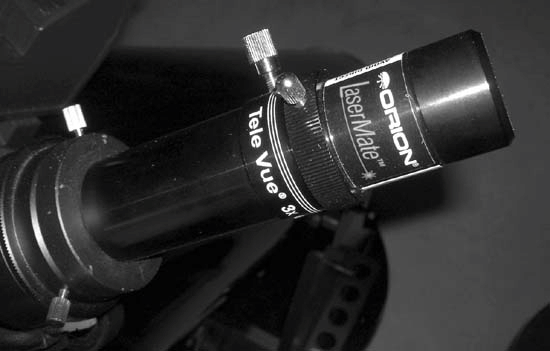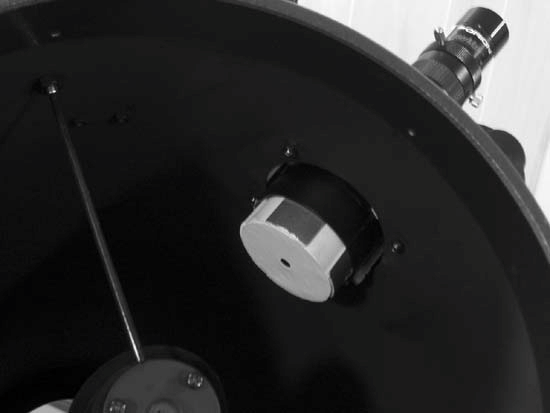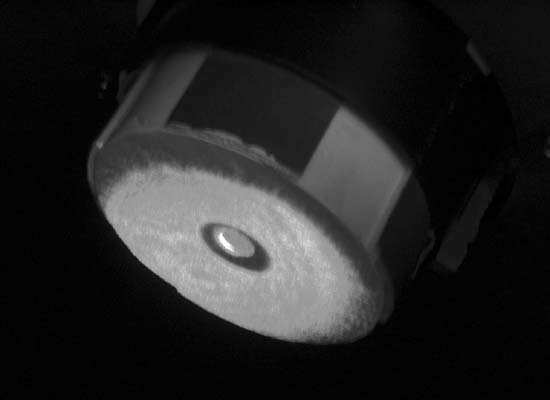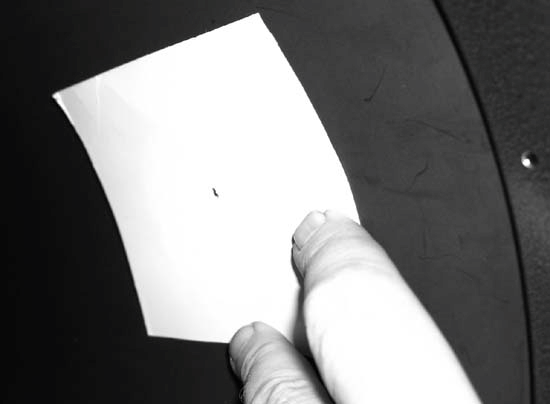Hack39.Collimate Your Primary Mirror Quickly and Accurately
Hack 39. Collimate Your Primary Mirror Quickly and Accurately
Use a Barlowed laser to show the error of the primary only, taking the secondary out of the equation. In the January 2003 issue of Sky & Telescope magazine, Nils Olof Carlin describes a simple and accurate method of collimating the primary mirror of a Newtonian reflector. Carlin's method uses a laser collimator and Barlow lens in combination, as shown in Figure 3-20. Figure 3-20. Insert the Barlow between the laser collimator and the focuser The new method is preferable in several ways to the standard one in which the laser collimator is used alone. The most striking improvement is that the new method is insensitive to collimation errors of the other elements in the optical path, namely the secondary and the focuser. These should have been collimated before the tilt of the primary is adjusted, of course, but decoupling the primary from the other elements vastly simplifies the final part of the work, namely, adjusting the primary mirror. Carlin's method, like the standard one using a simple laser collimator, involves inspecting the light coming back from the primary. In both cases, the reflected light returns to a target, and the tilt of the primary is adjusted until the return beam is centered on this target. With the usual method, the target is the face of the laser, and the narrow return beam must be centered on the hole in the face. In Carlin's method, the beam is a diverging one, and the target is a disk of white cardboard, pierced by a hole at its center, which may be freestanding or attached to the Barlow. The tilt of the primary is adjusted until the shadow of the center spot you have affixed to the primary mirror falls on the hole in the target. Both methods become a bit clumsy when the targetthe laser face or the bottom of the Barlowsits so high in the focuser tube that it is not easily seen from the front of the scope. Carlin suggests using an auxiliary mirror to allow a better view of the target. We have tried this and find it inconvenient. What has worked much better for us is a target which extends a bit into the body of the scope. This is easily visible from the front of the tube and, being located at fingertip distance, allows the shadow of the center spot to be moved with sub-millimeter accuracy. (Not that such accuracy is needed: the position of neither the center spot on the primary nor the center of the target is likely to be all that accurate.) There are many ways to construct such a target. All that is needed is a tube that can be inserted into the focuser from below, of such diameter and surface as to fit snugly in place. The target is glued to the tube at its lower end. Our tube, with target attached, fits the 2" focuser on our XT10 Dob. Had we been using a 1.25" focuser, we could instead have used a plastic 35mm film container, such as is commonly used to make a collimating cap by cutting away the bottom and drilling a small hole at the center of the top [Hack #37]. Although you could be more elegant, we used a PVC plumbing fitting, one normally used to couple a threaded metal pipe to a smooth PVC pipe. We chose it to be loose enough in the focuser tube that its diameter could be shimmed out with self-adhesive foam, namely, by four Scotch Brand Mounting Squares, each 1/16" thick and 1" square, that were on hand. The foam has just enough give to allow the fixture to be easily slid in and out, to be held firmly in place, and to not scratch the inside of the focuser tube. Our target, epoxied to the lower end of the PVC fixture, was made from a piece of index card stock, which was easy to trace the circle on, to cut out, and to punch through with a hand-held paper punch. The card stock proved to be a bit too thin: sufficient light from the illuminated back came through the front to make the shadow of the center spot a bit difficult to see. Rather than replacing the original target and constructing a new one, we simply painted over the front of the target with white latex paint. Latex dries flexible and would not flake off in use, depositing flakes on the optics as a harddrying Krylon or spray paint might have done. Figure 3-21 shows our completed target, inserted in the bottom of the 2" focuser. Figure 3-21. The completed Barlowed laser target in the focuser Before first using the target to perform an actual collimation, we determined the direction on the target (e.g., toward the finder, toward the open end of the tube, etc.) toward which the shadow of the center spot moves when we tightened each of the primary collimation screws separately. With that information recorded on a handy reference card, we found that tweaking the primary into precise collimation takes only about a minute after inserting the laser-Barlow combination into the focuser tube from above. Figure 3-22 shows the appearance of the Barlowed laser on the target when the primary is slightly out of collimation. The donut-shaped shadow of the center spot on the primary mirror is shifted slightly away from the hole through which the laser exits. Figure 3-22. An offset center spot shadow indicates miscollimation Figure 3-23 shows the appearance of the Barlowed laser on the target when the primary is collimated. The donut-shaped shadow of the center spot on the primary mirror is centered on the hole through which the laser exits. You can even use the Barlowed laser method to collimate your primary mirror if you've forgotten to pack your target. Simply punch a small hole in a piece of heavy paper or thin cardboard stock to make a field-expedient target, as shown in Figure 3-24. Insert the Barlow into the focuser, the laser collimator into the Barlow, and turn on the laser. Slide the target around until the laser beam exits through the hole in the card, and examine the return pattern on the face of the card. When the donut-shaped shadow of the center spot is centered on the laser exit hole, your primary is collimated.
Figure 3-23. A center spot shadow concentric with the laser exit hole indicates the primary is collimated Figure 3-24. A field-expedient Barlowed laser target Collimating the primary by using Carlin's Barlowed laser method does require that the batteries in the laser be reasonably fresh: the Barlowed return beam is much fainter (because of the large area it covers) than is the concentrated return beam of the un-Barlowed laser. But, as far as I can tell, changing the batteries in the laser a bit more often is the only price you pay to use what is clearly a much cleaner and faster way of collimating the primary than any other I have seen. Gene A. Baraff |
EAN: 2147483647
Pages: 112
